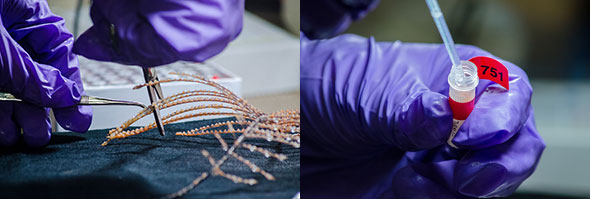What lives in the deep sea? For the most part, we still don’t know.
That is why the Ocean Genome Legacy (OGL) has joined with the National Oceanic and Atmospheric Administration (NOAA) ship Okeanos Explorer to help discover and preserve deep-sea biodiversity. This week, thanks to this partnership, OGL added a new set of rare deep-sea DNA samples to its online catalog.
Okeanos is the Greek word for ocean, and Okeanos Explorer is one of America’s premier ships for ocean exploration. Currently, Okeanos Explorer is on a campaign to investigate U.S. marine protected areas in the Pacific, such as the recently expanded Papahānaumokuākea Marine National Monument in the Hawaiian Archipelago and the Mariana Trench, the deepest part of the ocean.

The crew uses Deep Discoverer, a remotely operated vehicle (ROV), to descend into the depths and record footage of otherworldly seascapes and amazing creatures such as corals, sea lilies, squat lobsters, and brand new species unknown to the world. The crew also collects samples using the ROV’s robotic arm. These samples are then processed onboard and subsampled for OGL using the “OGL in a box” kit. Once Okeanos makes it back to port, the samples are shipped to Northeastern’s Marine Science Center for DNA extraction and storage. The samples from these deep-sea communities from the 2015 and 2016 expeditions are available online in the OGL catalog.
Thank you, NOAA! You can follow along with the 2017 Okeanos mission live!
The OGL biorepository works with researchers, educators, and citizen scientists around the globe to preserve valuable DNA samples, foster research, and promote discovery. If you would like to support our efforts, please consider making a gift.
